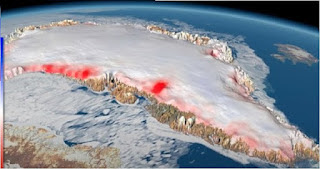The Dire Consequences of Melting Ice Sheets
From 2007 to 2017, the cumulative loss of ice mass due to meltwater and ice deterioration was in alignment with the most severe predictions by the Intergovernmental Panel for Climate Change (IPCC). These forecasts predict that by 2100 these ice sheets could contribute up to 40 centimetres (nearly 16 inches) to global sea levels, as reported in Nature Climate Change.
Such growth in sea level would inflict devastating global impacts, bolstering the destructive potential of storm surges and subjecting coastal areas, home to hundreds of millions of people, to recurrent and severe flooding.
Inadequacies of Current Climate Change Models
This is almost three-fold the median projections from the IPCC's latest main Assessment Report in 2014, which projected a 70-centimetre sea level rise from all sources, including mountain glaciers and ocean water expansion due to warming.
Despite the evident discrepancy between the observed acceleration of ice sheet disintegration and the models monitoring these trends, a special IPCC report last year upheld the same century-end projections for Greenland and only permitted a minor increase from Antarctica under the highest greenhouse gas emission scenario.
**Heading: The Need for Accurate Sea Level Projections**
"We need to rethink the worst-case scenario for the ice sheets as they are already melting at a rate consistent with our existing one," said Thomas Slater, lead author and researcher at the Centre for Polar Observation and Modelling at the University of Leeds, while speaking to AFP. He further emphasized the importance of accurate sea level projections in aiding governments in planning climate policy, mitigation, and adaption strategies. "If we underestimate future sea level rise, then these measures might be insufficient and leave coastal communities exposed," he added.
The High Cost of Underestimation
Underestimation could expose around 50 million people to annual coastal flooding worldwide by mid-century, as per research published last year. A total sea level rise of at least a metre would likely necessitate expenditures exceeding $70 billion annually for sea walls and other flood defences.
The Shortcomings of Current Ice Sheet Models
Several factors explain why the UN's climate models might have underestimated the impact of ice sheets. While these models accurately depict the long-term effects of gradual global warming, which has led to a more rapid temperature rise at the poles, they fail to account for short-term weather pattern fluctuations, which are significantly impacted by climate change.
"For Greenland, much of the ice loss is now being driven by surface melt events during hot summers - processes not captured in the AR5 simulations," said Slater, referring to the 2014 IPCC report, the fifth since 1992."We needs to understand these better to improve our sea level rise predictions."
Until the turn of the 21st century, the West Antarctic and Greenland ice sheets generally accumulated as much mass as they shed. Runoff, in other words, was compensated by fresh snowfall.
But over the last two decades ago, the gathering pace of global warming has upended this balance.
Last year, Greenland lost a record 532 billion tonnes of ice - the equivalent of six Olympic pools of cold, fresh water flowing into the Atlantic every second. This run-off accounted for 40 percent of sea level rise in 2019.
A new generation of climate models that better reflects how ice sheets, the oceans and the atmosphere interact will underpin the IPCC's next major report, which will be completed next year, said Slater.
In another study published earlier this month in The Cryosphere, a journal of the European Geosciences Union, Slater and colleagues calculated that Earth's ice masses - including mountain glaciers, the Arctic ice cap, and both ice sheets - lost nearly 28 trillion tonnes of mass between 1994 and 2017.
Less than half of that amount contributed to sea level rise. The Arctic ice cap, for example, forms in the ocean, and thus does not increase sea level when it melts.
The rate of ice loss, they found, has increased nearly 60 percent of that time period.


Post a Comment